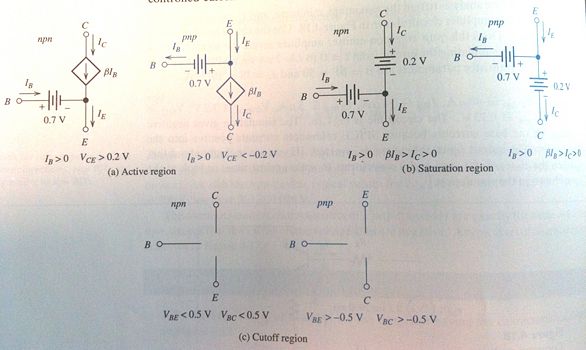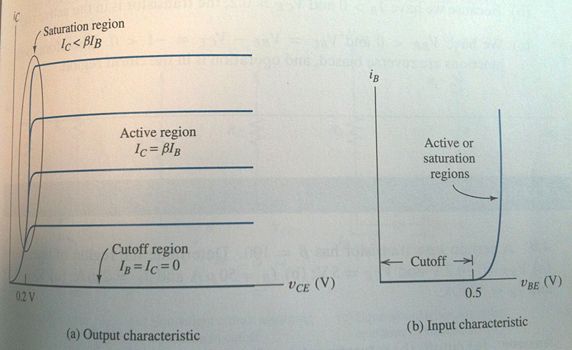Chapter 4: Difference between revisions
Jump to navigation
Jump to search
| Line 62: | Line 62: | ||
*For P3.17 make the glob of sauder assuming they're all on and check the currents running through each one. Make sure they go the right way, and add up? |
*For P3.17 make the glob of sauder assuming they're all on and check the currents running through each one. Make sure they go the right way, and add up? |
||
*Why do they make such a big deal about biasing the BJTs? Is that all they're really used for? |
*Why do they make such a big deal about biasing the BJTs? Is that all they're really used for? |
||
==References== |
|||
</references> |
|||
Revision as of 16:40, 3 March 2010
Bipolar Junction Transistor
- NPN: Not Pointing iN
- PNP: Pointing iN Please
- The arrow is for the emitter current.
- For an NPN the current flows into the collector. For a PNP the current flows out of the collector.
How a BJT works
Large-Signal DC models
|
|
- Active: The normal mode of operation. This mode has the largest common-emitter current gain.
- Reverse Active: The collector and emitter roles are reversed. Most BJTs are not symmetrical, thus and take on different values.
- Saturation: High current from the emitter to collector. Logical "on".
- Cutoff: Very little current flow. Logical "off".
Large-Signal DC Analysis
- Assume an operating region for the BJT.
- Solve the circuit to find
- Check the values to see if they match the region constraints.
Bias-Circuit Design
- The principle goal of bias-circuit design is to achieve nearly identical operating points for the BJTs, even though the BJT parameters may vary significantly from unit to unit. <ref>Electronics p245</ref>
- Fixed-base bias circuit is a very simplistic method that does not deal well with a wide variety of values. The base current does not adjust for changes in . If you want a circuit that has a particular operating point on the collector load line, the base current must change with .
- Using two voltage sources (one for the collector and one for the base) achieves an emitter current that is relatively independent of . Usually only one source is available or we may wish to inject a signal into the base. In an ideal world you could simply place the voltage sources in series. Since the voltage sources are grounded, they would be put in parallel. The wire connecting the voltage source will see the potential difference (and a lot of current). The wire will burn up and bad things will happen to the voltage sources.
- Four-resistor bias circuit provides a constant base voltage independant of .
Questions
- Why do we always seem to use a common emitter configuration? Common-base and common-collector have different properties.
- Daisy chaining the voltage doubler? Go up?
- For P3.17 make the glob of sauder assuming they're all on and check the currents running through each one. Make sure they go the right way, and add up?
- Why do they make such a big deal about biasing the BJTs? Is that all they're really used for?
References
</references>












